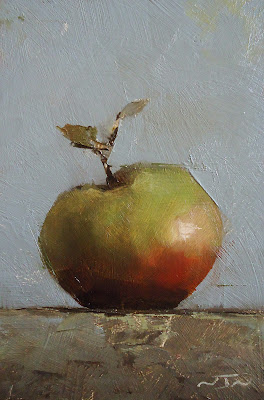Linseed Oil #2 - oil on panel
Occasionally - either accidentally or deliberately - I revert to a much looser style of painting, allowing a large amount of the ground of the painting and the canvas to show through. For me, this is usually a raw umber tone. When using the stained canvas itself as a major unifying value within the painting, I'm always surprised by how little actual painting work needs to be done to make the painting work. When I do this, I do no real underpainting - using a fairly dry brush to just block in the basic shapes and suggest the structure of the subject, as quickly as possible - whilst allowing the stained canvas to hold the piece together in a unified way. The umber ground acts a middle tone for the entire piece and does the bulk of the work. All that's really needed are the darkest darks and the lightest lights, along with some suggestion of structure and mass in the middle range. I suppose the key is to put just the bare minimum onto the canvas to make it look like the subject. The painting comes together surprisingly quickly and, when it works out, I think is much more interesting to look at - warmer and more dynamic.
Anders Zorn was a master of this technique in his looser work as well as Sargent in most of his portraits….
 |
| Anders Zorn - Antonin Proust |
 |
| Anders Zorn - Coquelin Cadet |
|
|
 |
| John Singer Sargent - Robert Louis Stevenson |
|
|
|
I know this isn't a new or surprising technique, but I'm always aware that I don't do it often enough. Staying aware of this approach and keeping it in mind is the challenge, and like most people I never know when to stop and usually end up overdoing it and spoiling the simplicity of the painting.
Keeping this in mind I picked up the old linseed oil bottle again and had another shot at it, trying to stay simple and let the underpainting do most of the work. The result is above.





 Matchbox #1 - 6" x 8" - oil on panel
Matchbox #1 - 6" x 8" - oil on panel
 Mustard - 20cm x 14cm - oil on panel
Mustard - 20cm x 14cm - oil on panel
 I was never too happy with the last compartment painting, which was the last post I made. I thought there was something about the label on the bottle which didn't work and the whole thing looked a bit too much like an underpainting, so I decided to do some more work on it. I took out the label, half filled the bottle with grapeseed oil - which I think draws together the greens and yellows more, and repainted most of the background. I think it has a lot more depth to it now.
I was never too happy with the last compartment painting, which was the last post I made. I thought there was something about the label on the bottle which didn't work and the whole thing looked a bit too much like an underpainting, so I decided to do some more work on it. I took out the label, half filled the bottle with grapeseed oil - which I think draws together the greens and yellows more, and repainted most of the background. I think it has a lot more depth to it now.